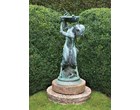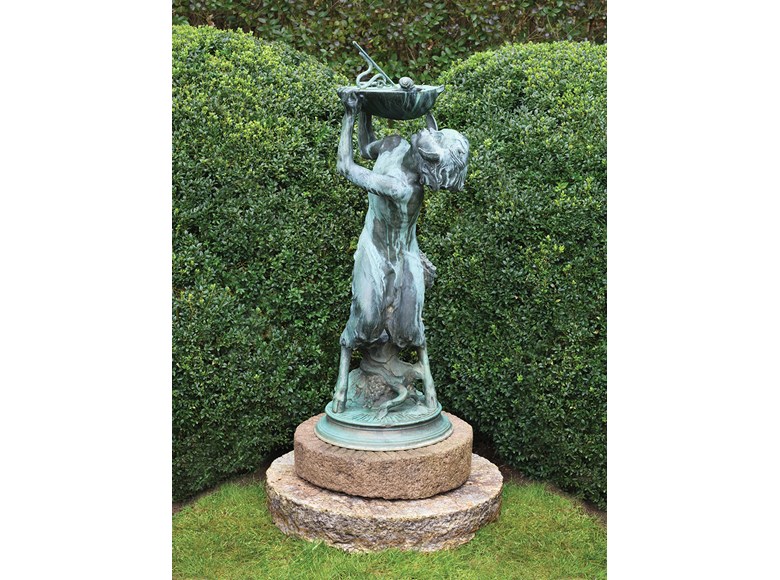 BACK TO GALLERY
BACK TO GALLERY
Barbara Israel Garden Antiques
Bronze Figural Sundial of a Child Satyr
Bronze Figural Sundial of a Child Satyr
47.5 ins. high, 18 ins. overall diameter
description
A bronze figural sundial with satyr figure by American sculptor Robert Ingersoll Aitken (1878-1949), the satyr holding a large stylized shell while crouched beneath it, the shell topped with a sundial plate, the sundial’s gnomon embellished with a serpent, the dial plate inscribed “AMICIS QUAELIBET HORA”, translated “Friends at any hour”, and “FRANKLIN MURPHY / FOUNDER AND HEAD OF THE / MURPHY VARNISH COMPANY / BY THE EMPLOYEES ON THE FIFTIETH ANNIVERSARY / OF ITS ESTABLISHMENT / AUGUST NINETEEN HUNDRED AND FIFTEEN”, with a snail perched on the edge of the shell, the satyr with face turn upward in communication with the snail, and with bunches of grapes at his hooves, the whole upon circular molded base with geometric patterning, inscribed on base “AITKEN / FECIT” and “ROMAN BRONZE WORKS”, American, 1915.
Robert Aitken studied at the Mark Hopkins Institute of Art [also called the California School of Design--now the San Francisco Art Institute] and was an instructor at the institute from 1901 to 1904. His early commissions include the Victory figure at the top of the Dewey Monument in San Francisco’s Union Square and the figure of the Republic for the William McKinley Memorial in Panhandle Park, San Francisco. In 1904, Aitken moved to Paris to continue his studies, and then in 1907 settled in New York where he was employed as an instructor at the Art Students League. Further works include the Science fountain and Great Rivers statues at the Missouri State Capitol, several military statues at West Point, and the “Fountain of the Earth” produced for the Panama Pacific Exposition in 1915. Aitken’s best known work is the West Pediment of the United States Supreme Court building, commissioned by architect Cass Gilbert (1867-1934), and completed in 1935. The pediment depicts nine figures, including Liberty, Order, Authority, two figures of Council, Research Past, Research Present, the Chairman of the Supreme Court Building Commission, and Aitken himself. While many of Aitken’s works were civic commissions, he also designed a great many medals and was an accomplished portraitist. This satyr sundial, being a whimsical piece meant for use in the garden, was unusual within the scope of Aitken’s normal production. Besides this one, there is one other cast of the satyr sundial mentioned in the March 25, 1916 edition of American Art News.
Robert Aitken studied at the Mark Hopkins Institute of Art [also called the California School of Design--now the San Francisco Art Institute] and was an instructor at the institute from 1901 to 1904. His early commissions include the Victory figure at the top of the Dewey Monument in San Francisco’s Union Square and the figure of the Republic for the William McKinley Memorial in Panhandle Park, San Francisco. In 1904, Aitken moved to Paris to continue his studies, and then in 1907 settled in New York where he was employed as an instructor at the Art Students League. Further works include the Science fountain and Great Rivers statues at the Missouri State Capitol, several military statues at West Point, and the “Fountain of the Earth” produced for the Panama Pacific Exposition in 1915. Aitken’s best known work is the West Pediment of the United States Supreme Court building, commissioned by architect Cass Gilbert (1867-1934), and completed in 1935. The pediment depicts nine figures, including Liberty, Order, Authority, two figures of Council, Research Past, Research Present, the Chairman of the Supreme Court Building Commission, and Aitken himself. While many of Aitken’s works were civic commissions, he also designed a great many medals and was an accomplished portraitist. This satyr sundial, being a whimsical piece meant for use in the garden, was unusual within the scope of Aitken’s normal production. Besides this one, there is one other cast of the satyr sundial mentioned in the March 25, 1916 edition of American Art News.






 SEND AN EMAIL
SEND AN EMAIL
 (917) 494-8177
(917) 494-8177